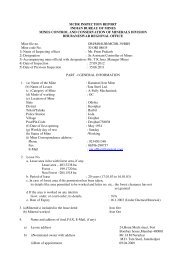Market Survey on Copper - Indian Bureau of Mines
Market Survey on Copper - Indian Bureau of Mines
Market Survey on Copper - Indian Bureau of Mines
Create successful ePaper yourself
Turn your PDF publications into a flip-book with our unique Google optimized e-Paper software.
The use <strong>of</strong> zinc sulphate reduces the c<strong>on</strong>sumpti<strong>on</strong> <strong>of</strong> cyanide and therefore<br />
many copper beneficiati<strong>on</strong> plants use cyanide - ZnSO4 combinati<strong>on</strong> as zinc<br />
depressant. Sometimes organic reagents, such as, starch, tannin, dyes,<br />
quebracho and dextrine are also used as depressants. These are used in small<br />
quantity to depress talc, graphite and calcite. Starch is used to depress<br />
molybdenite in copper-molybdenum separati<strong>on</strong>.<br />
vi) pH Modifiers : pH plays an important role in flotati<strong>on</strong> <strong>of</strong> sulphides as<br />
well as n<strong>on</strong>-sulphide. Lime, sodium hydroxide, sodium carb<strong>on</strong>ate, sulphuric<br />
acid, etc. are used as pH modifiers.<br />
<strong>Copper</strong> flotati<strong>on</strong> is usually carried out in alkaline medium. Lime, being<br />
very cheap, is widely used to regulate/raise pulp alkalinity. It prevents the<br />
adverse effect <strong>of</strong> soluble salts <strong>on</strong> flotati<strong>on</strong> by precipitating them as metal<br />
hydroxides. It is also used as depressant for pyrite and arsenopyrite in copper<br />
flotati<strong>on</strong>. It has no depressing effect <strong>on</strong> copper minerals but does depress<br />
galena. Sulphuric acid is used to bring down pH below 7 which is required for<br />
flotati<strong>on</strong> <strong>of</strong> pyrites.<br />
As already stated, the beneficiati<strong>on</strong> process may differ in the presence <strong>of</strong><br />
a group <strong>of</strong> gangue as well as other metallic ores; therefore, use <strong>of</strong> collectors,<br />
frothers, activators, depressants, pH modifiers may differ from simple ores to<br />
complex ores.<br />
C) Dewatering<br />
Many <strong>of</strong> the mineral separati<strong>on</strong> techniques involve use <strong>of</strong> substantial<br />
quantity <strong>of</strong> water. Final test product need to be dewatered to produce dry<br />
product required for shipment. Dewatering process can be broadly classified<br />
into three groups:<br />
a) Sedimentati<strong>on</strong>/thickening<br />
b) Filtrati<strong>on</strong><br />
c) Drying<br />
Dewatering in mineral processing is normally a combinati<strong>on</strong> <strong>of</strong> the above<br />
groups. The bulk <strong>of</strong> water (up to 80%) is removed by thickening which result in a<br />
thickened pulp up to 60% solid by weight. Filtrati<strong>on</strong> <strong>of</strong> the thickened pulp yields a<br />
moist cake c<strong>on</strong>taining 10 to 20% moisture which may require thermal drying to<br />
produce a dry product c<strong>on</strong>taining up to 5% moisture.<br />
The filtrati<strong>on</strong> units in copper processing plants employ drum and disc filters<br />
with disc having slight edge. Filter capacity also varies c<strong>on</strong>siderably and ranges<br />
between 0.4 to 1.0 tpd per sq. ft. filter area. A large number <strong>of</strong> mills use driers to dry<br />
the copper c<strong>on</strong>centrates. Dryers are used for many reas<strong>on</strong>s - usually because the filter<br />
cake is too wet to strip or because the smelter requires a product with less moisture.<br />
Spray, rotary drum and multiple hearth dryers are used in copper mill. Rotary dryers<br />
are most comm<strong>on</strong>.<br />
36
















